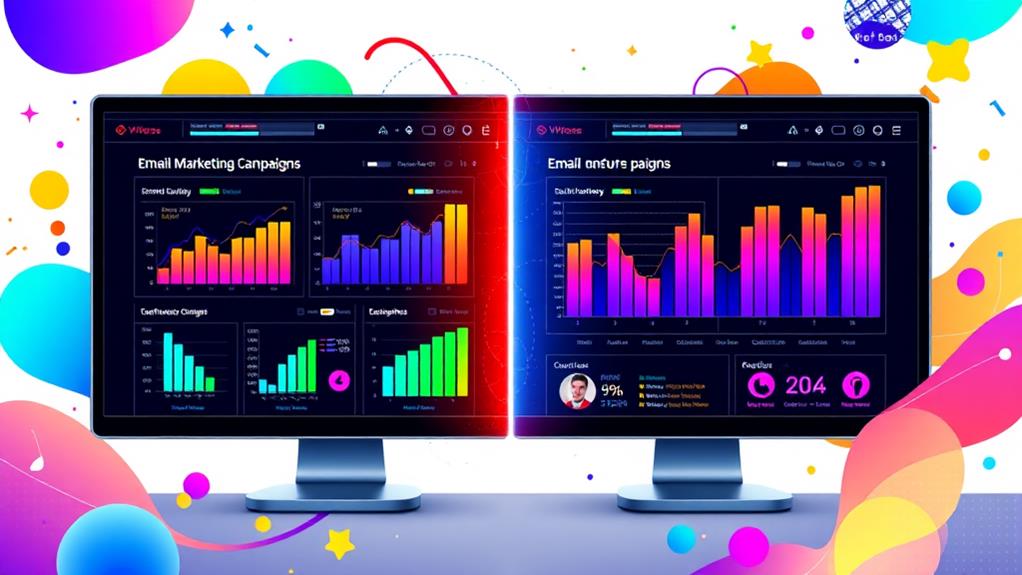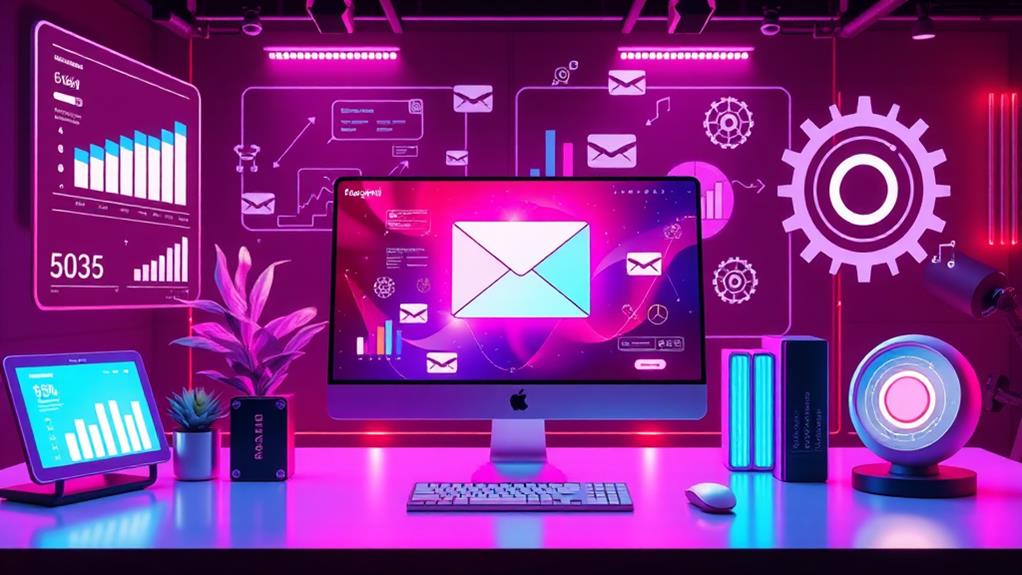Segmenting your email list is a strategic approach that enhances engagement and ROI in email marketing campaigns. By implementing demographic, behavioral, and geographic segmentation, you can tailor content to specific audience needs, resulting in a 14.31% higher open rate and driving conversion rates up to 10 times higher. Personalization through segmentation greatly reduces unsubscribe rates and fosters customer loyalty. Automated tools offer seamless updates based on consumer behavior, ensuring your messages stay relevant and compelling. This practice maximizes outreach effectiveness, positioning your business for sustainable growth and success. To reveal the full potential of these strategies, explore further guidance.
Key Takeaways
- Utilize demographic data to create personalized content for different audience segments, enhancing engagement.
- Implement behavioral segmentation by analyzing purchase history and interactions for precise targeting.
- Use geographic segmentation to deliver location-specific promotions and increase local engagement.
- Apply psychographic segmentation to tailor emotionally resonant messages that foster brand loyalty.
- Continuously monitor and update segments to ensure high open and click-through rates.
Understanding Email Segmentation
Email segmentation is a strategic pillar of modern marketing that empowers businesses to maximize their outreach effectiveness. By dividing an email list into targeted groups based on specific criteria such as demographics, behaviors, and purchase history, businesses can greatly enhance the relevance of their communications.
The importance metrics associated with segmentation are compelling; segmented email campaigns contribute to 77% of email marketing ROI, underlining the essential impact of personalization on engagement and conversion rates. This data-driven approach not only improves open rates but also boosts click-through rates, as subscribers are more likely to engage with content tailored to their interests.
However, segmentation challenges cannot be overlooked. The dynamic nature of consumer behavior necessitates continuous monitoring and updating of segmented lists. Marketers must navigate diverse segmentation types—demographic, behavioral, geographic—to maintain message relevancy.
The strategic allocation of resources to regularly analyze and adjust these segments is imperative for sustaining campaign effectiveness. In addition, ensuring the accuracy and timeliness of data collection is fundamental in overcoming segmentation challenges.
As businesses endeavor to enhance their marketing outcomes through segmentation, understanding and addressing these challenges becomes essential for leveraging the full potential of this powerful marketing tool.
Key Benefits of Segmentation
Without a doubt, one of the most compelling advantages of segmentation lies in its considerable impact on email marketing ROI, boosting it by an impressive 77%. This enhancement is largely due to the alignment of tailored campaigns with specific subscriber behavior and demographic targeting, ensuring messages resonate more effectively with their intended audience.
Segmented email lists not only achieve 14.31% higher open rates but also foster deeper engagement, as evidenced by personalized emails driving conversion rates up to 10 times higher than their generic counterparts.
Strategically implementing segmentation offers several key benefits:
- Enhanced Engagement: By understanding subscriber behavior, marketers can craft targeted messages that considerably improve click-through rates by approximately 100%.
- Reduced Unsubscribe Rates: Relevant and personalized content reduces unsubscribe rates by up to 9%, building a more loyal subscriber base that is less likely to disengage.
- Increased Sales and Retention: Targeted emails that leverage demographic data can boost sales and enhance customer retention, creating a more profitable and sustainable marketing strategy.
Types of Email Segments
In the domain of email marketing, understanding the various types of email segments is essential for crafting strategies that enhance campaign effectiveness. By leveraging demographic factors, marketers can tailor content to specific age groups, genders, or locations, greatly increasing the relevance of their messaging.
Behavioral triggers, such as purchase history and email interaction, allow for precise targeting based on engagement metrics, guaranteeing that campaigns resonate with customers' buying patterns.
Geographic trends enable businesses to send localized promotions, adapting offers to align with regional preferences. This segmentation tactic guarantees that recipients receive content that is geographically relevant, thereby boosting engagement rates.
Psychographic profiles explore deeper into consumer interests, values, and lifestyles, offering insights that inform highly personalized marketing strategies. Such segmentation helps in understanding the motivations behind customer actions, leading to more meaningful connections.
Lifecycle nuances further refine segmentation by categorizing customers according to their journey stage, from new subscribers to lapsed customers. This approach facilitates customized messaging, guiding recipients through the sales funnel efficiently.
Automating Your Segmentation
Having explored the diverse types of email segments, it becomes clear that the next logical step is to harness automation to enhance segmentation practices.
Automating your email segmentation allows for real-time adjustments based on customer behavior, thereby increasing the accuracy and efficiency of your marketing campaigns. By leveraging dynamic triggers, marketers can facilitate instant segmentation updates, adapting to shifting customer preferences with agility. This ability to swiftly respond to changes can lead to significant improvements in engagement metrics, such as open and click-through rates.
Utilizing email marketing platforms with built-in segmentation tools is a strategic move that saves time and resources. These platforms enable marketers to focus on crafting compelling content rather than getting bogged down in manual data sorting.
Furthermore, automated segmentation guarantees that targeted messages reach specific groups, enhancing the likelihood of meaningful interaction.
In summary, automation in segmentation offers the following advantages:
- Real-time Adjustments: Respond to customer behavior instantly with dynamic triggers.
- Resource Efficiency: Free up time for content creation by using built-in tools.
- Enhanced Engagement: Improve open and click-through rates through precise targeting.
Effective Segmentation Strategies
Often, the success of email marketing hinges on the implementation of effective segmentation strategies tailored to the specific needs and behaviors of the audience. By leveraging demographic insights, businesses can craft messages that resonate with different age groups, genders, and locations, thereby enhancing personalization. This approach is vital, as segmented emails are responsible for 77% of email marketing ROI according to DMA.
Behavioral segmentation focuses on analyzing customers' purchase history and engagement levels. By identifying behavioral triggers, marketers can design targeted campaigns that re-engage lapsed customers or reward loyal ones, greatly boosting conversion rates. Geographic segmentation further enriches this strategy by delivering location-specific offers, enhancing local engagement—a key tactic for businesses with physical locations.
Adopting psychographic segmentation allows for a deeper understanding of customers' values and lifestyles, enabling emotionally resonant messaging that fosters brand affinity and loyalty. Ongoing monitoring and updates of these segments, based on evolving data and engagement metrics, are necessary to maintaining high open and click-through rates.
| Segmentation Type | Key Benefits |
|---|---|
| Demographic | Personalization, higher engagement |
| Behavioral | Targeted campaigns, improved conversions |
| Geographic | Local relevance, enhanced engagement |
| Psychographic | Emotional resonance, brand loyalty |
Strategically implementing these segmentation strategies guarantees a robust email marketing framework.
Frequently Asked Questions
How Should You Segment Your Email List?
To effectively segment your email list, employ demographic targeting to tailor content by age and location. Leverage behavioral insights from purchase history and engagement metrics to create personalized campaigns, enhancing relevance and fostering stronger subscriber engagement and conversion.
What Is Email Segmentation Based on Engagement?
Email segmentation based on engagement involves categorizing subscribers by analyzing engagement metrics and subscriber behavior. This strategy enhances targeting effectiveness, enabling marketers to deliver personalized content and optimize campaign performance by addressing varying levels of engagement and interaction.
How Would You Segment an Email List to Personalize Content Effectively?
To personalize content effectively, employ demographic targeting to tailor messages based on age, gender, and location. Complement this with behavioral analysis, utilizing purchase history and engagement metrics to deliver relevant, timely content, considerably enhancing engagement metrics and conversion rates.
What Are the Examples of Categories You Can Use to Segment Your Email Subscribers?
Email subscribers can be strategically segmented using demographic factors such as age and location, alongside purchase history, to enhance engagement. This approach leverages targeted messaging, resulting in higher transaction rates and improved customer engagement outcomes.
Conclusion
Email segmentation emerges as a pivotal strategy for enhancing engagement, driven by its ability to deliver tailored content to distinct audience subsets. The strategic implementation of segmentation not only optimizes open and click-through rates but also fosters customer loyalty and conversion rates. By leveraging automation, organizations can streamline segmentation processes, ensuring timely and relevant communication. Employing data-driven segmentation strategies is imperative for maximizing the effectiveness of email marketing campaigns, ultimately leading to sustained customer engagement and business growth.




